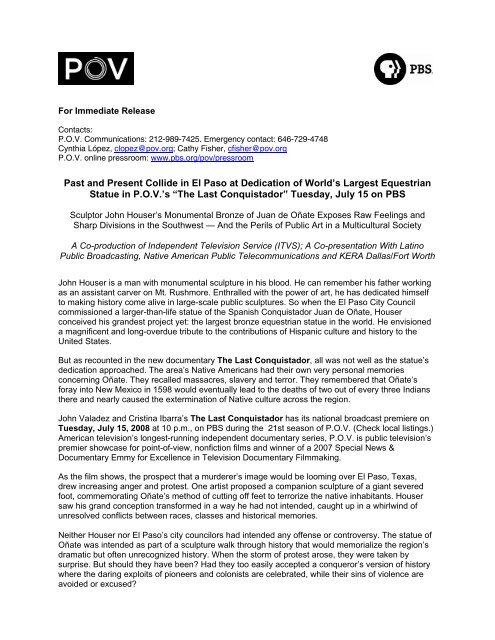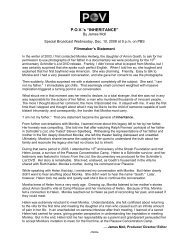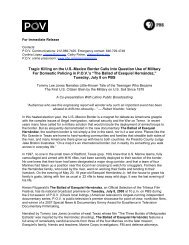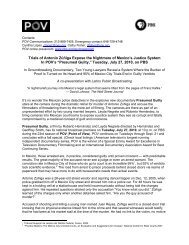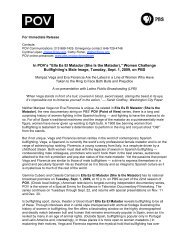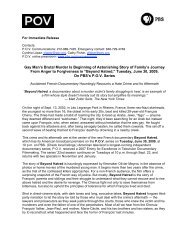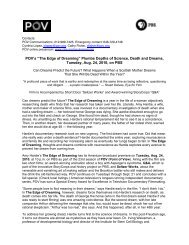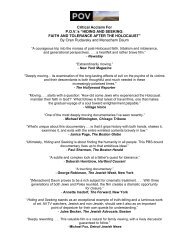Press Release - American Documentary, Inc.
Press Release - American Documentary, Inc.
Press Release - American Documentary, Inc.
You also want an ePaper? Increase the reach of your titles
YUMPU automatically turns print PDFs into web optimized ePapers that Google loves.
For Immediate <strong>Release</strong>Contacts:P.O.V. Communications: 212-989-7425. Emergency contact: 646-729-4748Cynthia López, clopez@pov.org; Cathy Fisher, cfisher@pov.orgP.O.V. online pressroom: www.pbs.org/pov/pressroomPast and Present Collide in El Paso at Dedication of World’s Largest EquestrianStatue in P.O.V.’s “The Last Conquistador” Tuesday, July 15 on PBSSculptor John Houser’s Monumental Bronze of Juan de Oñate Exposes Raw Feelings andSharp Divisions in the Southwest — And the Perils of Public Art in a Multicultural SocietyA Co-production of Independent Television Service (ITVS); A Co-presentation With LatinoPublic Broadcasting, Native <strong>American</strong> Public Telecommunications and KERA Dallas/Fort WorthJohn Houser is a man with monumental sculpture in his blood. He can remember his father workingas an assistant carver on Mt. Rushmore. Enthralled with the power of art, he has dedicated himselfto making history come alive in large-scale public sculptures. So when the El Paso City Councilcommissioned a larger-than-life statue of the Spanish Conquistador Juan de Oñate, Houserconceived his grandest project yet: the largest bronze equestrian statue in the world. He envisioneda magnificent and long-overdue tribute to the contributions of Hispanic culture and history to theUnited States.But as recounted in the new documentary The Last Conquistador, all was not well as the statue’sdedication approached. The area’s Native <strong>American</strong>s had their own very personal memoriesconcerning Oñate. They recalled massacres, slavery and terror. They remembered that Oñate’sforay into New Mexico in 1598 would eventually lead to the deaths of two out of every three Indiansthere and nearly caused the extermination of Native culture across the region.John Valadez and Cristina Ibarra’s The Last Conquistador has its national broadcast premiere onTuesday, July 15, 2008 at 10 p.m., on PBS during the 21st season of P.O.V. (Check local listings.)<strong>American</strong> television’s longest-running independent documentary series, P.O.V. is public television’spremier showcase for point-of-view, nonfiction films and winner of a 2007 Special News &<strong>Documentary</strong> Emmy for Excellence in Television <strong>Documentary</strong> Filmmaking.As the film shows, the prospect that a murderer’s image would be looming over El Paso, Texas,drew increasing anger and protest. One artist proposed a companion sculpture of a giant severedfoot, commemorating Oñate’s method of cutting off feet to terrorize the native inhabitants. Housersaw his grand conception transformed in a way he had not intended, caught up in a whirlwind ofunresolved conflicts between races, classes and historical memories.Neither Houser nor El Paso’s city councilors had intended any offense or controversy. The statue ofOñate was intended as part of a sculpture walk through history that would memorialize the region’sdramatic but often unrecognized history. When the storm of protest arose, they were taken bysurprise. But should they have been? Had they too easily accepted a conqueror’s version of historywhere the daring exploits of pioneers and colonists are celebrated, while their sins of violence areavoided or excused?
In that history, Oñate set out in 1598 from Mexico on a thousand-mile journey seeking new landsand Christian converts for Spain along with riches for himself. He was the first governor of NewMexico, and brought wheat, horses, metalworking and Western ideas to what became the <strong>American</strong>Southwest. But Oñate’s brutality was well understood by his contemporaries. He was eventuallyrecalled, tried and convicted by the Spanish Crown for what would today be called crimes againsthumanity. He was banished forever from New Mexico, and ended up moving to Spain.While Native <strong>American</strong>s are deeply offended, many wealthy whites and Hispanics throughout theregion — who trace their ancestry back to the Oñate expedition — welcome the monument anddefend the bloodshed, saying the Indians were the aggressors and that Oñate brought peace andstability to the region.Caught in between are the Mestizos, Mexican-<strong>American</strong>s like El Paso City Councilman AnthonyCobos who make up about 75 percent of El Paso’s population. The sons and daughters of both theSpaniards and the Indians they subjugated, they must struggle with a conflicted heritage that is bothprideful and humiliating. Councilman Cobos eventually withdraws his support for the statue and paysa heavy political price.John Houser, who had worked on his labor of love for 10 years, eventually feels the pressure: helearns that he has glaucoma and may eventually lose his eyesight. Haunted by the heavy moralburden of his own creation and his failing health, he apologizes for being blind to the socialimplications of his work. “I have developed my own trap,” he says, “and I think about it day andnight.”But the damage is done. Deep wounds have been opened and a bitter divide has deepened. In theend, many Hispanics are elated, Mestizos are frustrated that valuable public money has been usedfor the sculpture, and Native <strong>American</strong>s feel that the genocide of their people matters little to the Cityof El Paso or to white people who walk the corridors of power.John Houser is proud of the art but dismayed by how it is perceived. But resilient and determined asever, he is planning to make up for it with a statue commemorating pre-Columbian Indian life — ahuman figure 28 times life-size and five feet higher than the Statue of Liberty!The Last Conquistador is a production of the Kitchen Sync Group, <strong>Inc</strong>./Valadez Media inassociation with Independent Television Service (ITVS), Latino Public Broadcasting, Native<strong>American</strong> Public Telecommunications, and KERA Dallas/Ft. Worth. Funding provided by theNational Endowment for the Arts, the National Endowment for the Humanities, the Sundance<strong>Documentary</strong> Fund, Humanities Texas and the New York State Council on the Arts.About the filmmakers:John J. ValadezExecutive Producer/Writer/Producer/DirectorJohn Valadez has been producing and directing award-winning documentaries for PBS and CNN forthe past 14 years. His credits include the critically acclaimed “Passin’ It On,” which aired on P.O.V in1994. He also was a producer for three PBS series: Making Peace, Matters of Race, and Visiones:Latino Arts & Culture. He was a producer of “Beyond Brown” for PBS, and produced “High StakesTesting” for CNN Presents. Valadez is currently working on two PBS projects: writing and directingthe third hour of the four-hour series Latin Music USA and producing “The Head of JoaquinMurrieta.”Valadez is a founding member of the New York City Chapter of the National Association of LatinoIndependent Producers (NALIP). He is a Rockefeller Fellow and a PBS/CPB Producers AcademyFellow, and currently sits on the Board of Trustees of the Robert Flaherty Film Seminar. He hastwice been a New York Foundation for the Arts Fellow and is a graduate of the film program at NewYork University’s Tisch School of the Arts; Valadez lives in Warwick, N.Y.
Cristina IbarraProducer/DirectorThis is Cristina Ibarra’s first feature documentary. For the past eight years, she has been makingshort films that have been seen on public television and in galleries, museums, schools and filmfestivals across the United States including at the Guggenheim Museum, Exit Art Gallery, and theQueens Museum. Her award-winning directorial debut, “Dirty Laundry: A Homemade Telenovela,”aired on the PBS series ColorVision. She has also produced interstitials for Latino PublicBroadcasting, the New York International Latino Film Festival and fulana, a Latina multimediacollaborative. Some of her credits include “Grandma’s Hip Hop,” “Amnezac,” and “Wheels ofChange.” Ibarra is a Rockefeller Fellow, a New York Foundation for the Arts Fellow and a CPB/PBSProducers Academy Fellow. She is a founding member of NALIP; fulana; and SubCine, the firstLatino self-distribution collective. Ibarra, who lives in Brooklyn, N.Y., is currently developing twoprojects: a documentary entitled “Another Martha” and a feature film entitled “Love & MonsterTrucks.”Credits:Executive Producer:Producer/Director:Writer:Director of Photography:Editor:Original Music:John J. ValadezJohn J. Valadez, Cristina IbarraJohn J. ValadezElia LyssyKeiko Deguchi, Jean-Phillipe BoucicautRichard MartinezRunning Time: 56:46The Independent Television Service (ITVS) funds and presents award-winningdocumentaries and dramas on public television, innovative new media projects on the Weband the Emmy Award-winning weekly series Independent Lens on PBS. ITVS is a miracleof public policy created by media activists, citizens and politicians seeking to foster pluralityand diversity in public television. ITVS was established by a historic mandate of Congress to championindependently produced programs that take creative risks, spark public dialogue and serve underservedaudiences. Since its inception in 1991, ITVS programs have revitalized the relationship between thepublic and public television, bringing TV audiences face-to-face with the lives and concerns of their fellow<strong>American</strong>s. More information about ITVS can be obtained by visiting itvs.org. ITVS is funded by theCorporation for Public Broadcasting, a private corporation funded by the <strong>American</strong> people.Created in 1998 by Edward James Olmos and Marlene Dermer, Latino PublicBroadcasting (LPB) is a non-profit organization funded by the Corporation for PublicBroadcasting. LPB’s mission is to support the development, production, post-production,acquisition and distribution of non-commercial educational and cultural television that isrepresentative of or addresses issues of particular interest to U.S. Latinos. Theseprograms are produced for dissemination to public broadcasting stations and other publictelecommunications entities. Mr. Olmos is presently LPB’s Chairman of the Board of Directors. For moreinformation please visit www.lpbp.org.Native <strong>American</strong> Public Telecommunications (NAPT) is one of five national consortiachartered by the Corporation for Public Broadcasting (CPB) to provide minorityprogramming to the public broadcasting system. For 32 years, NAPT has supported thecreation, promotion and distribution of Native public media. NAPT support has made itpossible to bring to the PBS audience such quality programs as Indian Country Diaries,Unnatural Causes, The Oneida Speak, Way of the Warrior and many others. More information about NAPT isavailable at www.nativetelecom.org. Other award-winning services of NAPT include the AIROS NativeNetwork, www.airos.org, and Visionmaker Video, www.visionmaker.org, distributor of authenticdocumentaries by and about Native <strong>American</strong>s. NAPT receives major support from CPB and the FordFoundation.
Produced by <strong>American</strong> <strong>Documentary</strong>, <strong>Inc</strong>. and celebrating its 21st season on PBS in2008, the award-winning P.O.V. series is the longest-running showcase on television tofeature the work of America's best contemporary-issue independent filmmakers. AiringTuesdays at 10 p.m., June through September, with primetime specials during the year, P.O.V. hasbrought more than 250 award-winning documentaries to millions nationwide, and now has a WebbyAward-winning online series, P.O.V.'s Borders. Since 1988, P.O.V. has pioneered the art of presentationand outreach using independent nonfiction media to build new communities in conversation about today'smost pressing social issues. More information about P.O.V is available online at www.pbs.org/pov.P.O.V. Interactive (www.pbs.org/pov)P.O.V.'s award-winning Web department produces special features for every P.O.V. presentation,extending the life of our films through filmmaker interviews, story updates, podcasts, streaming video, andcommunity-based and educational content that involves viewers in activities and feedback. P.O.V.Interactive also produces our Web-only showcase for interactive storytelling, P.O.V.’s Borders. Inaddition, www.pbs.org/pov has launched the P.O.V. Blog, a gathering place for documentary fans andfilmmakers to discuss and debate their favorite films, get the latest news and link to further resources. TheP.O.V. Web site, blog and film archives form a unique and extensive online resource for documentarystorytelling.P.O.V. Community Engagement and Education<strong>American</strong> <strong>Documentary</strong> | P.O.V. works with local PBS stations, educators and community organizationsto present free screenings and discussion events to inspire and engage communities in vitalconversations about our world. As a leading provider of quality nonfiction programming for use in publiclife, P.O.V. offers an extensive menu of resources, including free discussion guides and curriculum-basedlesson plans. In addition, P.O.V.’s Youth Views works with youth organizers and students to provide themwith resources and training in order to use independent documentaries as a catalyst for social change.Major funding for P.O.V. is provided by PBS, The John D. and Catherine T. MacArthur Foundation,National Endowment for the Arts, The Educational Foundation of America, The Fledgling Fund, New YorkCity Department of Cultural Affairs, New York State Council on the Arts, Lower Manhattan CulturalCouncil, The September 11th Fund and public television viewers. Funding for P.O.V.'s Diverse VoicesProject is provided by the Corporation for Public Broadcasting. P.O.V. is presented by a consortium ofpublic television stations, including KCET Los Angeles, WGBH Boston and Thirteen/WNET New York.<strong>American</strong> <strong>Documentary</strong>, <strong>Inc</strong>. (www.amdoc.org)<strong>American</strong> <strong>Documentary</strong>, <strong>Inc</strong>. (AmDoc) is a multimedia company dedicated to creating, identifying andpresenting contemporary stories that express opinions and perspectives rarely featured in mainstreammedia outlets. AmDoc is a catalyst for public culture, developing collaborative strategic engagementactivities around socially relevant content on television, online and in community settings. These activitiesare designed to trigger action, from dialogue and feedback to educational opportunities and communityparticipation. Simon Kilmurry is executive director of <strong>American</strong> <strong>Documentary</strong> | P.O.V.DVD REQUESTS: Please note that a broadcast version of this film is available upon request, asthe film may be edited to comply with new FCC regulations.Media Sponsor:


